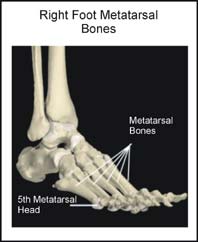In order to understand this condition, it is important to understand the anatomy and function of the foot. Please read Foot Pain Info’s section on basic foot anatomy. For additional background information on the biomechanics of the foot please read Foot Pain Info’s section on basic foot and ankle biomechanics.

What is metatarsalgia?
The metatarsal bones are the longest bones in the foot. The ends of these bones are called the “metatarsal heads”. Metatarsalgia is a general term used to describe a common cause of pain in the sole of the foot, under the metatarsal heads.
What does metatarsalgia feel like?
The pain from metatarsalgia is felt on the bottom of the foot, underneath the metatarsal heads. The pain can be dull or sharp, constant or intermittent. Poor footwear, particularly high-heeled shoes can make metatarsalgia worse. Often callouses, can be found on the sole of the foot, under the metatarsal heads.
What causes metatarsalgia?
There are three arches in the foot. There is an inner (medial) arch, an outer (lateral) arch and an arch in the forefoot called the transverse (metatarsal) arch. The metatarsal bones form part of the metatarsal arch. Ligaments are like strong ropes that connect bones and provide stability to joints. In the foot there are numerous ligaments that also support the three arches. Over time the ligaments that support the metatarsal arch can become “stretched out” and lose their effectiveness. As a result the metatarsal arch loses its shape and more pressure is placed on the heads of the middle three metatarsal bones. This added pressure results in pain. Loss of the metatarsal arch is one of the most common causes of metatarsalgia.
Can metatarsalgia be detected on X-rays, blood tests or other tests?
In most cases of metatarsalgia, extra tests are not required to make the diagnosis. Blood tests, X-rays, bone scans, ultrasounds and MRI scans are usually performed to rule out other possible causes of forefoot pain such as a metatarsal stress fracture, Morton’s neuroma, arthritis of the MTP joints, or injury to the metatarsal heads i.e. osteochondrosis.
What is the treatment for metatarsalgia?
The treatment for metatarsalgia should be individualized. The most important first step in the treatment (and prevention) of metatarsalgia is to wear proper shoes and avoid shoes with high heels. Further treatment may include relative rest from activity or prolonged standing, medications to reduce inflammation and pain, stretching and strengthening exercises, a pad to support the metatarsal arch, or custom shoe orthotics.
What other information is available on metatarsalgia?
Foot Pain Info ‘s links section has additional information on this topic. Links have been provided to other websites as well as online medical journals. Visit Joint Pain Info for information on other joint injuries and problems.
